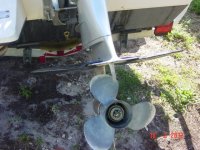Robbi
Active member
- Joined
- Mar 23, 2004
- Messages
- 1,193
- Reaction score
- 0
- C Dory Year
- 2023
- C Dory Model
- 23 Venture
Ive just spent my first night on my 2004 16 C. As many of you know, my last boat was a 19, and I've owned a 16 Angler which I took on a few cruises.
I'm sitting in the V-berth with my back againist the port side of the cabin. I'm drinking my first cup of coffee and watching the sunrise. I have a 360 degree view of the outside, which is not possible in the 19. I like this, very comfortable. Plus, the body contortions needed to exit the V-berth in the 19, a thing of the past. : )
I've removed the passenger seat and the table. I'm using the seat box for a table. My jetboil is set up there and I can reach that and most everything else in the boat from my sitting position. That's nice.
Im having to rethink what I really need and what is just extra "stuff" that get's in the way, but I think that is the case for any small cruising boat. There really is lots of starage space, with the seat boxes and the room under the V-berth. The area under the berth requires good planning as the storage boxes are not readily at hand.
I admire the couples that take extended cruises in a 16. I think it must be a intimate and well choreographed "dance". I think we all could learn much about overall boat management from them.
I've mounted a Wallas 1300 on the port side of the cabin just below where the table attaches. This is going to be nice for fall and winter day and overnight cruises. Nice too, to warm and dry out the cabin on summer mornings.
Fuel burn is close to half of what the 19 was. The Honda 40 just purrs along, a bit loud, but not bad. I bought a Permatrim but I haven't mounted it yet. I wanted to gather as much performance data as I could before I mount it so that I can share the before and after information.
On the down side. Other than being small, lack of room, more rocking and rolling in chop and boat wakes, I think this boat is going to be a great little cruiser for the south sound and the San Juans. Plus, I can cast a fly line over the cabin top, unlike the 19. So, what's not to like?
Robbi
I'll be adding pictures soon.
I'm sitting in the V-berth with my back againist the port side of the cabin. I'm drinking my first cup of coffee and watching the sunrise. I have a 360 degree view of the outside, which is not possible in the 19. I like this, very comfortable. Plus, the body contortions needed to exit the V-berth in the 19, a thing of the past. : )
I've removed the passenger seat and the table. I'm using the seat box for a table. My jetboil is set up there and I can reach that and most everything else in the boat from my sitting position. That's nice.
Im having to rethink what I really need and what is just extra "stuff" that get's in the way, but I think that is the case for any small cruising boat. There really is lots of starage space, with the seat boxes and the room under the V-berth. The area under the berth requires good planning as the storage boxes are not readily at hand.
I admire the couples that take extended cruises in a 16. I think it must be a intimate and well choreographed "dance". I think we all could learn much about overall boat management from them.
I've mounted a Wallas 1300 on the port side of the cabin just below where the table attaches. This is going to be nice for fall and winter day and overnight cruises. Nice too, to warm and dry out the cabin on summer mornings.
Fuel burn is close to half of what the 19 was. The Honda 40 just purrs along, a bit loud, but not bad. I bought a Permatrim but I haven't mounted it yet. I wanted to gather as much performance data as I could before I mount it so that I can share the before and after information.
On the down side. Other than being small, lack of room, more rocking and rolling in chop and boat wakes, I think this boat is going to be a great little cruiser for the south sound and the San Juans. Plus, I can cast a fly line over the cabin top, unlike the 19. So, what's not to like?
Robbi
I'll be adding pictures soon.


